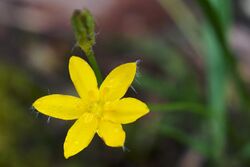Biology:Hypoxis hirsuta
| Hypoxis hirsuta | |
|---|---|

| |
| Scientific classification | |
| Kingdom: | Plantae |
| Clade: | Tracheophytes |
| Clade: | Angiosperms |
| Clade: | Monocots |
| Order: | Asparagales |
| Family: | Hypoxidaceae |
| Genus: | Hypoxis |
| Species: | H. hirsuta
|
| Binomial name | |
| Hypoxis hirsuta (L.) Coville
| |
| Synonyms | |
| |
Hypoxis hirsuta, commonly known as common goldstar,[1] common star-grass,[2] eastern yellow stargrass,[3] yellow star grass,[4] or yellow star flower,[5] is a perennial ornamental plant in the family Hypoxidaceae. Sometimes this plant is placed in the family Amaryllidaceae or the family Liliaceae. The species is native to the United States , Canada , and northeastern Mexico.[6][7][8][9]
Description
H. hirsuta has grass-like, basal leaves that are up to 30 cm (12 in) long and one or more shorter stems, growing up from the rosette of leaves to 20 cm (8 in) long. The leaves have smooth margins and are elliptical in shape. Both the leaves and the stem have scattered white hairs.[4]
Flowers appear April to May at the end of each stem in a group, or umbel, of 2 to 6, occasionally only 1. The flowers are 5–13 mm (0.2–0.5 in) long, with 3 yellow petals and 3 yellow sepals spreading outwards. The flowers will open in the morning but typically wilt in the hot afternoon sun. When not flowering, the plant can resemble grass, but it is not a grass.[10]
Etymology
The genus name Hypoxis is from the Greek words hypo and oxys, meaning "sharp below", referring to how the seedpods have a tapered base. The specific epithet hirsuta is Latin for "hairy".[11]
Distribution and habitat
H. hirsuta is native in the United States from New Mexico to the west, Texas to the south, the Canadian border to the north, and Maine to the east. In Canada, it is native in Manitoba, Saskatchewan, and Ontario. It is also native in northeastern Mexico, south to Tamualipas.[6] The plant grows in moist to slightly dry habitats such as prairies, savannas, open woodlands, fens, glades, abandoned fields, and lawns.[4]
Ecology
The flowers attract small bees that feed on its pollen.
Characteristics & Attributes
Soil Moisture
• Dry
• Average
• Low Maintenance
Ecoregion
Eastern Great Lakes Lowlands
Northeastern Coastal Zone
Atlantic Coastal Pine Barrens
Acadian Plains and Hills
Northeastern Highlands [12]
Exposure
• Sun
• Part Shade
References
- ↑ "USDA Plants Database". https://plants.sc.egov.usda.gov/home/plantProfile?symbol=HYHI2.
- ↑ "Hypoxis hirsuta (common star-grass): Go Botany". https://gobotany.nativeplanttrust.org/species/hypoxis/hirsuta/.
- ↑ "NatureServe Explorer 2.0". https://explorer.natureserve.org/Taxon/ELEMENT_GLOBAL.2.127933/Hypoxis_hirsuta.
- ↑ 4.0 4.1 4.2 "Yellow Star Grass (Hypoxis hirsuta)". https://www.illinoiswildflowers.info/prairie/plantx/yl_stargrassx.htm.
- ↑ "Hypoxis hirsuta". https://plantfinder.nativeplanttrust.org/plant/Hypoxis-hirsuta.
- ↑ 6.0 6.1 Kew World Checklist of Selected Plant Families
- ↑ Blanchan, Neltje (2005). Wild Flowers Worth Knowing. Project Gutenberg Literary Archive Foundation.
- ↑ Espejo Serena, A. & López-Ferrari, A.R. (1996). Las Monocotiledóneas Mexicanas una Sinopsis Florística 1(6): 1-116. Consejo Nacional de la Flora de México, México D.F.
- ↑ Biota of North America Program 2013 county distribution map
- ↑ "Hypoxis hirsuta page". http://www.missouriplants.com/Hypoxis_hirsuta_page.html.
- ↑ Denison, Edgar (2017). Missouri Wildflowers (Sixth ed.). Conservation Commission of the State of Missouri. pp. 127. ISBN 978-1-887247-59-7.
- ↑ Trust, Native Plant. "Hypoxis hirsuta". https://plantfinder.nativeplanttrust.org/plant/Hypoxis-hirsuta.
External links
- Hypoxis hirsuta
- USDA Plants Profile: Hypoxis hirsuta
- Hypoxis hirsuta at NatureServe[yes|permanent dead link|dead link}}]
Wikidata ☰ Q5961537 entry
 |


